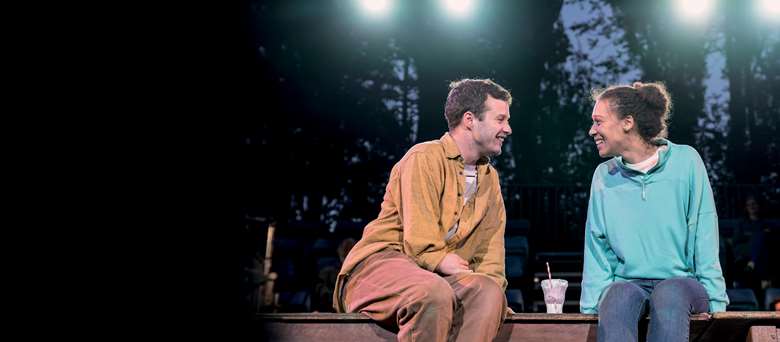Our Town by Thornton Wilder
Howard Sherman
Monday, March 1, 2021
Each issue of D&T we bring you a teachers’ guide to a play for study with your students, written by a fellow teacher. This issue, Howard Sherman introduces Wilder's Our Town and explores why it has long been one of the most-performed plays in US schools

Johan Persson
Our Town is one of the most performed plays in the American theatre canon. It debuted on Broadway in 1938, winning the Pulitzer Prize for Drama. Its last Broadway production was in 2002, starring Paul Newman. Its most recent UK productions include the Almeida Theatre (2014), the Royal Exchange Theatre (2017) and the Open Air Theatre in Regent's Park (2019). It is one of only two plays to rank among the half-dozen most performed plays in US high schools in every decade from the 1940s to the 2010s.
The plot
The slim plot of Our Town's three acts follows George and Emily, teens growing up next door to one another in Grover's Corners, New Hampshire, at the turn of the 20th century. They progress from friendship to romance to marriage, and we also see their parents’ marriages, their mothers’ friendship, and the basic functions of their small town.
When an untimely death befalls one of the pair, the play depicts the afterlife, and the conversation among Grover's Corners’ residents who have passed, as well as a brief return to life by one of the play's central characters. Each short glimpse of this rural life is interspersed with extensive commentary from a narrator called the Stage Manager, who begins by emphasising that the audience is watching a play, and who seems able to traverse the worlds of the living and the dead.
Design
The first words of the script read, ‘No curtains. No scenery.’ In its original production, the play used only tables, chairs, a narrow wood plank, A-frame ladders, and a pair of matching trellises; the back wall of the theatre was fully visible. Costumes were consistent with the place and period, spanning 1899 to 1913. While hand props were used intermittently, notably umbrellas in Act III, the majority of physical activity was mimed. The playwright cited Greek and Asian drama as important influences.
Modern productions often bend this edict and vary from the original look of the play, with many now putting actors in street or rehearsal clothes and supplementing – or subtracting – the scenery, albeit without unduly cluttering the stage. While Wilder had expressed his interest in having the play done in a big barn of a theatre, it easily scales down to intimate spaces and the company (with doubling) can number less than a dozen, or expand to more fully populate the town and, in particular, the church choir in each act, as well as the mourners in Act III.
Characteristics of the text
The language of Our Town is predominantly direct and unadorned, even when discussing ancient history and time across several millennia. Save for the Stage Manager's monologues, the characters have few long speeches and the scenes in the first two acts, in particular, seem ordinary, even mundane. The script does use New England colloquialisms of the period and renders some words in an approximation of dialect. Recent productions in the US and abroad have not adhered to the scripted accent, often allowing English speaking actors to simply use their own natural speech. The play has been translated into more than 80 languages, and some have used more than one language within the same production.
Context
While sometimes dismissed as a piece of antique and reactionary Americana, that fails to take in the play's quasi-Brechtian framework, constantly breaking away from dramatic scenes for extended periods where the Stage Manager, in direct address to the audience, considers the brevity of our time on earth and our place in the universe.
Wilder wrote that it was an attempt to present ‘the life of a village against the life of the stars.’ The third act is a meditation on mortality, subtly foretold in earlier dialogue, in which the climax comes not with action, but with the impassioned query, ‘Do any human beings ever realise life while they live it?–every, every minute?’
For student readers, Our Town requires an act of imagination akin to radio – in asking audiences to imagine a town without any visual cues. It asks students to engage with the most basic of life's eternal questions without adhering to any single school of thought, secular or religious. The play also takes on new meaning based upon the context of the time and place in which it is presented, set against political divisiveness or major tragedies, as its themes easily transcend the specificity of the time and place in the script.
Resources
For details about the life and work of Thornton Wilder, the definitive biography is Thornton Wilder: A Life by Penelope Niven (Harper Collins, 2012). The Wilder Family LLC maintains the comprehensive website. For scholarship on Wilder, visit the Thornton Wilder Society, publisher of the Thornton Wilder Journal.
The new book Another Day's Begun: Thornton Wilder's Our Town in the 21st Century (Methuen Drama, 2021) provides oral histories of a dozen US and UK approaches to Our Town since 2002, including many productions that vary gender identity, race, ethnicity, age, and disability, as well as design, from the original production in order to sustain the play's relevance to students and audiences after more than eight decades since its premiere. D&T readers can use the code OURTOWN35 for 35% off both print and eBook here.

